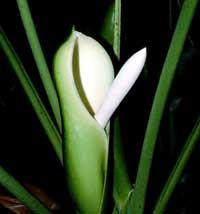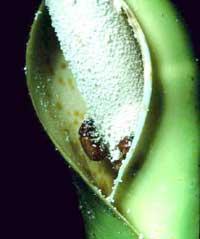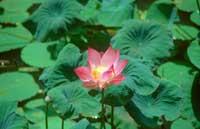Flower tempering

Philodendron solimoesense lives in the trees of French Guiana. The flower is very similar to what we call snake food: the petals are leafy and form a wrap around the inflorescence where pollen accumulates.
For that philodendron becomes a warm and sweet house at night. As if it were heated, it emits heat and maintains its daytime temperature. In fact, this tropical plant reaches a temperature of 27 ° C inside the flower, four degrees warmer than the night temperature outside.
The aroma of the flower attracts mainly beetles. And these beetles receive with enthusiasm the warm welcome made by the flower. They are so comfortable in flower tempering that they spend 90% of the time.
Bear in mind that beetle, being an insect, is a cold-blooded animal. This does not mean they carry cold blood exactly, but body temperature depends on room temperature. At night, when the environment cools, many cold-blooded animals lower the level of activity, that is, slow down and consume less energy.
However, the plant should have a live pollinating insect to drag the pollen that sticks to the body. Therefore, it is very beneficial that the flowers of the plant emit heat. To put it in some way, lukewarmness makes the beetle more working-class, allowing it to ensure that it carries pollen from one flower to another.


As already mentioned, the phylodendrone uses the beetle for pollination, that is, to extend the pollen of the flowers to other flowers and, at the same time, bring the pollen of other flowers. Thanks to this pollen, the flower is fertilized and, transforming it, the seed of a new plant is formed.
Pollination is vital for the species, otherwise it does not reproduce. Therefore, plants that need insects for pollination have very special tricks to attract them.
Flower and heating
Phylodendron flowers emit heat, but it is not the only plant that acts as a ‘heater’. Several plants in the Araceae family share the same behavior. And eight other families have found heat emitting species, including lotus flower.
It is said that these plants are thermoregulated, that is, their temperature does not vary, although it changes the around. For example, the plant known as symplocarpus foetidus, when covered with snow, manages to surface and melts the surrounding snow.
However, normally the plant does not emit heat so it does not freeze. In fact, most heat-producing plants live in temperate places. The aforementioned phylodendron is, for example, a tropical plant.
Plants that live in temperate places do not have to cope with the ice, but the competition that the flowers of the environment perform. And heat generation brings advantages to other species. There is more than one hypothesis, but there are those who think that the heat produced by the plant seeks to achieve the optimum temperature for the development of the flower. Another hypothesis is that heat facilitates the propagation of the sweet aroma of the flower, attracting more insects that help pollination.
Both hypotheses are acceptable and one does not eliminate the other. That is, heat can cause a correct development of the flower and, at the same time, contribute to the spread of the odor to the medium, since the compounds that form the vapor are volatile. This way it serves the plant to attract pollinating animals.
The prize is inside Lore
For a plant it is essential to attract pollinator to a flower. But, once achieved, he cannot let him escape immediately. The pollinator must resist inside or around the flower so that there is enough time to stick the pollen into the body.

The pollinator is attracted by the aroma of the flower or its striking appearance. And, once there, he receives the prize: pollen and nectar. The main food of the beetle is pollen. Therefore, the phylodendron flower has a lot of pollen, more than the beetle can eat. Thus, even when the insect has become saturated, many pollen grains remain, even attached to the body of the beetle.
To carry out the pollination it is essential that the pollinator go from one flower to another of plants of the same species. So many tricks for it. If the pollinator has been satisfied on a particular flower, then it will look for a flower of similar characteristics. Thus, the plant ensures its reproduction.
The phylodendron flower welcomes the beetle, a sweet pollen and a warm shelter to spend the night. Next time, surely, the beetle will choose a flower to spend the night.
Published in 7K.
Buletina
Bidali zure helbide elektronikoa eta jaso asteroko buletina zure sarrera-ontzian











